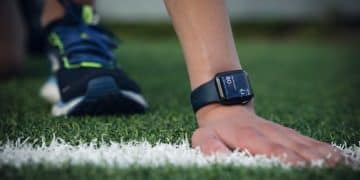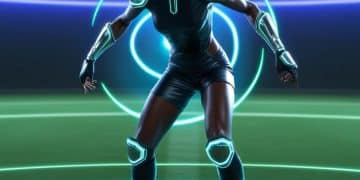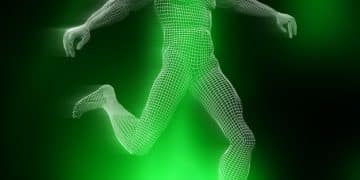Soccer Cleats Evolution: Material Science Enhances US Performance

The evolution of soccer cleats, driven by advancements in material science, has significantly enhanced player performance across US leagues by optimizing critical aspects such as traction, comfort, and injury prevention, fundamentally altering how athletes interact with the game.
The landscape of professional soccer in the United States has undergone a remarkable transformation, not only in terms of global recognition and talent but also in the very equipment that propels the sport forward. At the heart of this evolution lie the humble yet critical soccer cleats. Far from simple footwear, the modern cleat is a marvel of engineering and material science, meticulously designed to unlock unparalleled performance on the pitch. This comprehensive exploration delves into The Evolution of Soccer Cleats: How Material Science is Enhancing Performance in US Leagues, tracing their journey from rudimentary leather boots to high-tech instruments optimized for speed, agility, and injury reduction, ultimately shaping the future of the beautiful game in America.
The Genesis of a Game-Changer: Early Cleat Design
Early soccer cleats were a far cry from the highly specialized footwear players wear today. Initially, players simply wore their everyday leather shoes, often modified with metal tacks or hardened leather strips for rudimentary grip. The concept of purpose-built footwear for soccer emerged gradually, driven by the need for better traction on natural grass pitches, which were often muddy and unpredictable.
From Basic Leather to Crafted Boots
The foundational material for these early boots was almost exclusively heavy, rigid leather. This material provided a basic level of protection and durability, but little in terms of flexibility or comfort. The design was utilitarian, focusing solely on basic function.
- Heavy Leather Construction: Early cleats were typically crafted from thick, stiff cowhide, prioritizing sturdiness over agility.
- Fixed Studs: Wooden or metal studs were hammered directly into the sole, offering crude but essential grip.
- Minimal Arch Support: The internal structure lacked ergonomic design, leading to discomfort during extended play.
These designs, while primitive by today’s standards, laid the groundwork for future innovations. They established the fundamental need for specialized outsoles and stud configurations, even if the execution was rudimentary. The game was slower, less dynamic, and player movements were often hampered by the limitations of their footwear. The focus was predominantly on preventing slips, rather than enhancing speed or agility. As soccer began to gain traction in the US, especially in amateur and collegiate leagues, the demand for more effective equipment started to grow. Players and coaches alike recognized the potential for footwear to directly influence on-field dynamics.
The Mid-20th Century Shift: Lighter and More Agile
The mid-20th century brought the first significant shifts in cleat design. Post-World War II, European manufacturers like Adidas and Puma began experimenting with lighter leather and more ergonomic shapes, recognizing the need for speed and comfort. This period saw the introduction of screw-in studs, allowing players to adapt their traction to different pitch conditions. This was a revolutionary change, offering unprecedented versatility. The US market, though still smaller than in Europe or South America, gradually embraced these innovations as international play became more accessible.
The evolution of cleats from basic boots to more refined instruments marked a crucial turning point, setting the stage for the material science revolution that would define the late 20th and 21st centuries. This era highlighted the growing understanding that material choice directly impacted a player’s ability to perform.
The Material Science Revolution: Synthetics Take Center Stage
The latter half of the 20th century witnessed a paradigm shift in cleat manufacturing, driven by advancements in polymer science and composite materials. Synthetic materials began to replace traditional leather, offering lighter weights, enhanced durability, and unprecedented design versatility. This period marked the true beginning of the modern soccer cleat era, profoundly impacting US soccer culture from youth leagues to professional stages.
Lightness and Durability: The Synthetic Advantage
The primary driver for the adoption of synthetics was the pursuit of lighter footwear without compromising durability. Leather, while natural and breathable, absorbed water, becoming heavy and cumbersome in wet conditions. Synthetic microfibers, engineered plastics, and various composite materials offered solutions. These materials could be molded precisely, allowing for thinner, lighter uppers that retained their shape and resistance to the elements.
- Microfiber Uppers: Early synthetics mimicked leather’s feel but were significantly lighter and water-resistant.
- TPU and EVA Midsoles: These materials provided cushioning, impact absorption, and energy return, crucial for reducing player fatigue.
- Carbon Fiber Integration: High-performance cleats began incorporating carbon fiber plates in the outsole for stiffness, energy transfer, and a lighter feel.
These innovations were not merely incremental; they fundamentally altered how players could execute their game. Lighter cleats meant less energy expended per stride, leading to greater endurance and faster acceleration. The improved durability translated to longer lifespan for the boots, a practical benefit for players at all levels.
From Customization to Mass Production
Material science also enabled greater precision in manufacturing, moving away from handcrafted boots towards mass-produced, high-performance footwear. This allowed major brands to scale their operations and meet the growing demand, particularly in expanding markets like the US. The ability to engineer specific properties into synthetic materials meant that cleats could be designed for different player types—speedsters, playmakers, or defenders—each requiring distinct characteristics from their boots. This specialization was a significant leap forward, offering players boots tailored to their unique needs. Designers experimented with various textures and coatings on synthetic uppers to enhance ball control, swerve, and shot power. The tactile sensation of the ball on the foot was a key consideration, and material scientists worked to develop synthetics that offered an optimal balance of grip and feel.
The impact of this revolution on US leagues was profound. As more players had access to these advanced cleats, the overall pace and technicality of the game improved. Coaches noticed increased agility and responsiveness from their players, directly attributing it to the superior footwear. The transition to synthetics also opened the door for aesthetic innovations, with brands experimenting with vibrant colors and innovative patterns, making cleats a fashion statement as well as a performance tool.
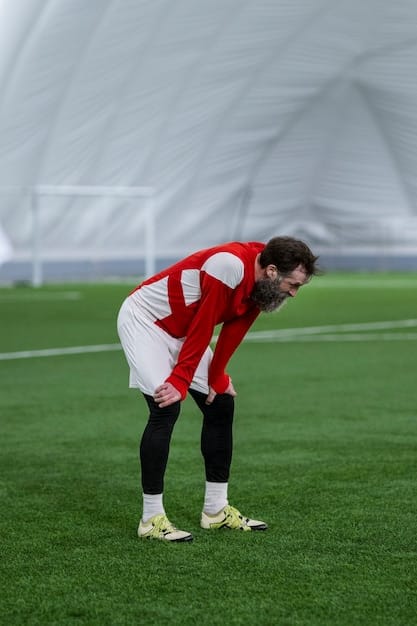
Traction Systems: Grip, Agility, and Pitch Versatility
Beyond the upper, the outsole and stud configuration remain perhaps the most critical elements of a soccer cleat, directly influencing a player’s interaction with the playing surface. The evolution of traction systems is a testament to the application of biomechanics and material science, driven by the diverse conditions of US soccer pitches.
Optimizing Stud Patterns for Different Surfaces
Early studs were primarily round and fixed, offering basic grip. However, as turf innovation advanced and natural grass quality varied across the US, a need emerged for more specialized stud patterns. Modern cleats now feature a wide array of configurations, each designed for specific performance benefits on different surfaces. For instance, conical studs are favored for rotational movements and ease of pivoting on natural grass, while bladed studs offer aggressive linear acceleration and braking.
- Firm Ground (FG) Cleats: Often feature a mix of conical and bladed studs, optimized for natural grass pitches.
- Soft Ground (SG) Cleats: Typically have fewer, longer, often metal-tipped studs that are ideal for muddy, wet conditions.
- Artificial Ground (AG) Cleats: Designed with numerous, shorter, hollow conical studs to reduce stud pressure and enhance grip on artificial turf.
The strategic placement and shape of these studs are not arbitrary; they are the result of extensive research into player movements, ground reaction forces, and injury prevention. Engineers use advanced computational fluid dynamics and pressure mapping to design optimal stud layouts that distribute pressure evenly, reduce hot spots, and maximize grip without compromising natural foot movement.
The Role of Outsole Materials
The material of the outsole itself is as crucial as the studs. Modern outsoles are predominantly made from lightweight, yet rigid, thermoset polyurethanes (TPU) or carbon fiber composites. These materials provide the stability and responsiveness needed for explosive movements. TPU offers flexibility and durability, while carbon fiber delivers exceptional stiffness and energy return, crucial for sprinters and players who rely on quick bursts of speed. Brands are also integrating innovative polymers that maintain their properties across a wider range of temperatures, ensuring consistent performance from the scorching heat of a Texas summer to the chilly air of a New England autumn.
The specific formulation of these polymers allows manufacturers to engineer targeted flex zones within the outsole, promoting natural foot flexion while maintaining stability where it’s most needed. This balance is critical for preventing injuries and enhancing overall comfort during a 90-minute match. The multi-density construction seen in some outsoles provides shock absorption in impact zones and enhanced rigidity in the propulsion zones.
The advent of multi-surface (MG) cleats, specifically tailored for the blending of natural and artificial grass found in many US training facilities and stadiums, further exemplifies this material-driven adaptability. These hybrid outsoles combine elements from both FG and AG configurations, offering a versatile solution for players who frequently transition between surfaces. This adaptability is particularly valuable in US leagues, where playing surfaces can vary considerably from one venue to another.
Comfort and Fit: Engineering for the Human Foot
Beyond performance, the material science revolution has also prioritized player comfort and fit. A well-fitting cleat reduces friction, prevents blisters, and allows a player to feel more connected to the ball and the ground. This focus on ergonomics has been a significant development, as discomfort can severely hinder a player’s ability to perform at their peak.
Adaptive Materials and Knitting Technologies
Traditional leather cleats required a lengthy break-in period to mold to the foot. Modern synthetics, combined with advanced manufacturing techniques like knitting, offer a “second-skin” fit right out of the box. Knitted uppers, often made from high-tenacity polyester or nylon fibers, are lightweight, breathable, and highly adaptable. These materials stretch and conform to the foot’s unique contours, providing a custom-like fit without the bulk.
- Knitted Construction: Materials like Nike’s Flyknit or Adidas’s Primeknit offer sock-like comfort and a seamless feel.
- Dynamic Fit Collars: Extended collars provide ankle support and a seamless transition from foot to leg, enhancing the locked-in sensation.
- Internal Skeletons: Strategically placed internal structures made from flexible polymers reinforce the upper without adding significant weight.
This adaptability not only enhances comfort but also improves ball control. The reduced bulk between the foot and the ball provides a more direct touch, allowing for greater precision in passes and shots. The seamless nature of knitted uppers also minimizes irritation points, a common issue with traditional sewn constructions.
Cushioning and Impact Absorption
The repeated impact of running and jumping on hard surfaces can take a toll on a player’s body. Material scientists have developed advanced cushioning systems to mitigate this stress. Midsoles crafted from ethylene-vinyl acetate (EVA) foams, often combined with proprietary cushioning technologies like encapsulated air units or thermoplastic polyurethane beads, absorb impact forces and provide energy return. This reduces fatigue and helps prevent long-term injuries to joints and muscles.
The strategic placement of padding within the cleat, particularly around the Achilles tendon and ankle bone, further enhances comfort and protection. These internal cushions, often made from memory foam or gel inserts, mold to the foot over time, providing personalized support. The focus on cushioning is particularly relevant in US leagues, where players may spend significant time on artificial turf, which can be less forgiving than natural grass. The emphasis on mitigating impact forces speaks directly to player welfare and longevity in the sport.
Data-Driven Design: The Intersection of Science and Sport
The evolution of soccer cleats has increasingly become a data-driven process, where scientific research, biomechanical analysis, and player feedback converge to create exceptionally high-performance products. This objective approach ensures that innovations are not merely theoretical but demonstrably translate into on-field benefits.
Biomechanics and Motion Capture
Leading brands employ extensive biomechanical analysis to understand how players move, sprint, cut, and strike the ball. High-speed motion capture systems track every micro-movement of the foot and cleat during various actions. This data informs the design of everything from stud placement to upper material extensibility. For instance, understanding the specific pressure points during acceleration helps engineers design outsoles that optimize energy transfer.
This granular analysis allows for a level of design precision previously unimaginable. It addresses factors like pronation, supination, and foot strike patterns, ensuring cleats provide adequate support and stability for a diverse range of foot types and playing styles. The biomechanical data also plays a crucial role in injury prevention, identifying stress points and developing materials and constructions that reduce strain on the player’s body. By minimizing unnecessary movement of the foot inside the boot, friction and shear forces are reduced, leading to fewer blisters and discomfort.
Performance Testing and Player Feedback
Before a new cleat hits the market, it undergoes rigorous performance testing. This involves laboratory simulations that mimic years of wear and tear, as well as extensive on-field trials with professional athletes. Elite players provide invaluable feedback, highlighting real-world performance nuances that might not be apparent in lab settings. This symbiotic relationship between science and athlete is crucial for refining designs.
- Lab Testing: Simulating wear, abrasion resistance, and material strength under extreme conditions.
- Elite Player Trials: Professional athletes test prototypes in real game scenarios, providing qualitative and quantitative feedback.
- Pressure Mapping: Sensors within the cleat measure pressure distribution during movement, informing design adjustments for comfort and performance.
The iterative process of design, testing, and feedback ensures that each new iteration of cleats is a refinement over its predecessor. Data on ball control, shot power, and agility are meticulously collected, allowing designers to quantify the tangible benefits of material and structural changes. This scientific rigor differentiates modern cleat development from earlier, more intuitive design processes. The continuous loop of data collection and refinement ensures that cleats are always at the forefront of performance innovation.
Injury Prevention: A Lifesaving Aspect of Cleat Design
While performance enhancement is a key driver, arguably the most vital contribution of material science to cleat evolution has been in injury prevention. Soccer is a sport characterized by explosive movements, sudden stops, and rapid changes in direction, all of which place immense stress on a player’s lower limbs. Cleats that mitigate these forces can significantly reduce the risk of debilitating injuries.
Strategic Stud Design and Distribution
Improper stud design or distribution can lead to excessive torque on the knee and ankle joints, particularly on artificial turf. Material scientists and engineers work to ensure that studs release from the ground efficiently, preventing the foot from getting “stuck.” This is especially critical on AG surfaces, where higher friction coefficients can exacerbate rotational forces. The development of conical and hollow studs for AG pitches explicitly addresses this concern, distributing pressure more evenly and allowing for smoother pivoting.
The spacing and material hardness of studs are meticulously controlled. For example, studs that are too long or too stiff for a hard ground can cause undue pressure on the sole, leading to discomfort and potential stress fractures. Conversely, studs that are too short on soft ground may lead to slips and falls. The nuanced design ensures that the cleat provides optimal grip without compromising joint health. The flexibility of the outsole material also plays a role, allowing the foot to move more naturally and absorb some of the rotational stress.
Advanced Cushioning and Support Systems
Beyond the outsole, the internal components of the cleat contribute significantly to injury prevention. Advanced cushioning materials in the midsole absorb shock, reducing the impact on knees, hips, and the spine. This is particularly important for US players who play extensively on artificial turf, which can be less forgiving than natural grass. Heel counters, typically made from rigid thermoplastic materials, lock the heel in place, preventing excessive movement and reducing the risk of Achilles tendon issues and ankle sprains.
The integration of dynamic support systems, such as internal cages or webbings, further stabilizes the foot within the cleat, minimizing lateral movement that could lead to instability. Ankle collars, whether traditional or the newer “dynamic fit” versions, offer proprioceptive feedback and a sense of security, which can reduce instances of ankle rolls. These layers of protection, engineered through careful material selection and structural design, allow players to push their limits with greater confidence and reduced risk. The focus on comprehensive foot and ankle protection underscores a growing commitment within the industry to player well-being.
The Future of Soccer Cleats: Smart Materials and Personalization
The journey of soccer cleats is far from over. The future promises even more sophisticated integration of material science, data analytics, and personalized manufacturing, pushing the boundaries of what footwear can achieve on the pitch. These advancements will continue to benefit players across US leagues, from youth to professional levels.
Integrated Smart Technologies
The next frontier involves embedding smart technologies directly into the cleat. Sensors could track granular performance data, from ground reaction forces to foot strike patterns and energy expenditure, providing real-time feedback to players and coaches. Imagine cleats that adapt their stud properties based on pitch conditions sensed by integrated micro-sensors, or uppers that dynamically adjust their fit based on foot swelling during a match.
- Embedded Sensors: Real-time data on speed, acceleration, and ball contact.
- Adaptive Materials: Polymers that change properties (e.g., stiffness, responsiveness) in response to external stimuli.
- 3D Printing: Custom-made outsoles and internal structures tailored to individual player biomechanics.
This data, combined with advanced analytics, could revolutionize training regimens, injury rehabilitation, and player scouting. It moves cleats beyond passive equipment to active performance enhancers and diagnostic tools. The focus will shift from generic performance to highly individualized optimization, bringing a new level of precision to player development.
Hyper-Personalization and Sustainability
The ultimate goal in cleat design is hyper-personalization, where every aspect of a cleat is tailored to an individual player’s unique biomechanics, playing style, and preferences. 3D printing and additive manufacturing technologies are making this vision a reality, allowing for bespoke outsoles, custom internal supports, and potentially even personalized stud configurations derived from an individual’s gait analysis. This level of customization promises unparalleled comfort, performance, and injury prevention.
Simultaneously, the industry is grappling with the environmental impact of manufacturing. Future cleats will likely incorporate an increasing proportion of sustainable and recycled materials, without sacrificing performance. Biodegradable polymers, closed-loop recycling processes, and reduced waste in manufacturing will become central to the design philosophy. The challenge will be to balance high performance with ecological responsibility, pushing material science to develop innovative solutions that benefit both the athlete and the planet. These environmentally conscious innovations will resonate with a growing demographic of players and consumers who prioritize sustainability.
The evolution of soccer cleats reflects an ongoing pursuit of perfection, merging the artistry of the game with the precision of science. As US soccer continues its ascent, the cleats worn by its athletes will remain at the forefront of this innovation, silently shaping every stride, every pass, and every goal.
Summing up the key advancements within the realm of soccer cleat evolution and material science. This table highlights how innovations are directly enhancing performance in US leagues.
| Key Aspect | Brief Description |
|---|---|
| 👟 Material Innovation | Transition from heavy leather to lightweight synthetics and carbon fiber for durability and speed. |
| 🚀 Traction Systems | Specialized stud patterns (FG, SG, AG) optimize grip and agility on diverse pitch conditions. |
| ☁️ Comfort & Fit | Knitted uppers and advanced cushioning provide a “second-skin” feel, reducing fatigue and enhancing responsiveness. |
| 🩹 Injury Prevention | Engineered stud release, shock absorption, and foot stabilization minimize stress on joints. |
Frequently Asked Questions about Soccer Cleat Evolution
▼
Material science has fundamentally transformed soccer cleats by introducing lightweight, durable synthetics, advanced rubber compounds, and carbon fiber. These innovations have allowed for lighter, more comfortable designs that offer superior grip, improved ball control, and better energy transfer, enhancing overall player performance and reducing fatigue on the field.
▼
Modern synthetic cleats offer several advantages over traditional leather, including significantly lighter weight, improved water resistance, and enhanced durability. They require less break-in time, provide a more consistent fit, and can be engineered with specific textures and coatings for better ball control and feel, maintaining performance in various weather conditions.
▼
Different stud configurations are optimized for specific US pitch conditions. Firm Ground (FG) studs are best for natural grass. Soft Ground (SG) studs excel in muddy conditions. Artificial Ground (AG) studs are designed to reduce pressure and friction on turf, preventing knee and ankle injuries. Choosing the right configuration ensures optimal traction, agility, and injury prevention.
▼
Cleats prevent injuries through strategic stud design that minimizes rotational forces on joints, advanced cushioning in midsoles to absorb impact, and supportive internal structures that stabilize the foot. These features reduce stress on ankles, knees, and hips, mitigating the risk of sprains, strains, and stress injuries, especially critical on varied playing surfaces.
▼
The future of soccer cleat technology is heading towards smart materials, integrated sensors, and hyper-personalization. Expect cleats that provide real-time performance data, adapt to changing pitch conditions, and are custom 3D-printed to an individual player’s foot biomechanics. Sustainability will also play a larger role, with more eco-friendly materials and manufacturing processes.
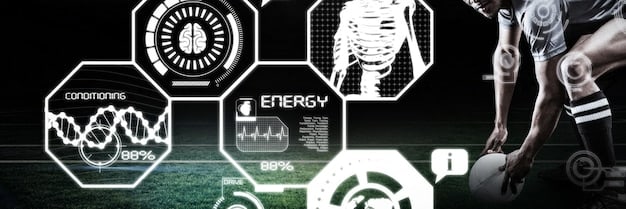
Conclusion
The transformative impact of material science on soccer cleats cannot be overstated. From basic leather boots to sophisticated, engineered instruments, the evolution of footwear in the sport, particularly within US leagues, mirrors the sport’s own growth in professionalism and scientific rigor. These advancements have not just made players fleeter and more agile but have also significantly prioritized their comfort and long-term well-being. As the beautiful game continues to captivate audiences and inspire athletes across the United States, the cleats they wear will undoubtedly remain at the forefront of innovation, continually redefining the boundaries of human performance on the pitch. The synergy between scientific discovery and athletic demand ensures that the journey of the soccer cleat is a dynamic, ongoing saga, promising even more groundbreaking developments in the seasons to come.

